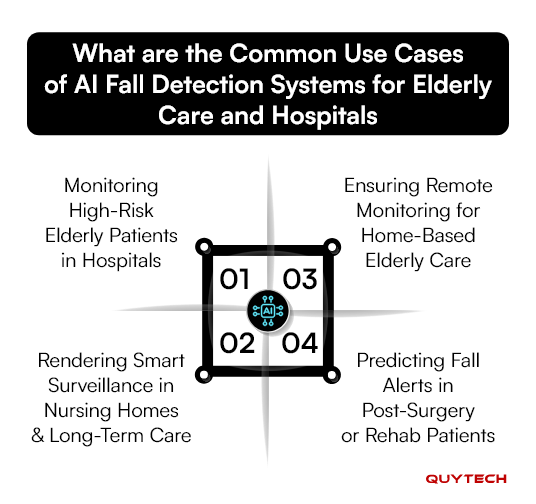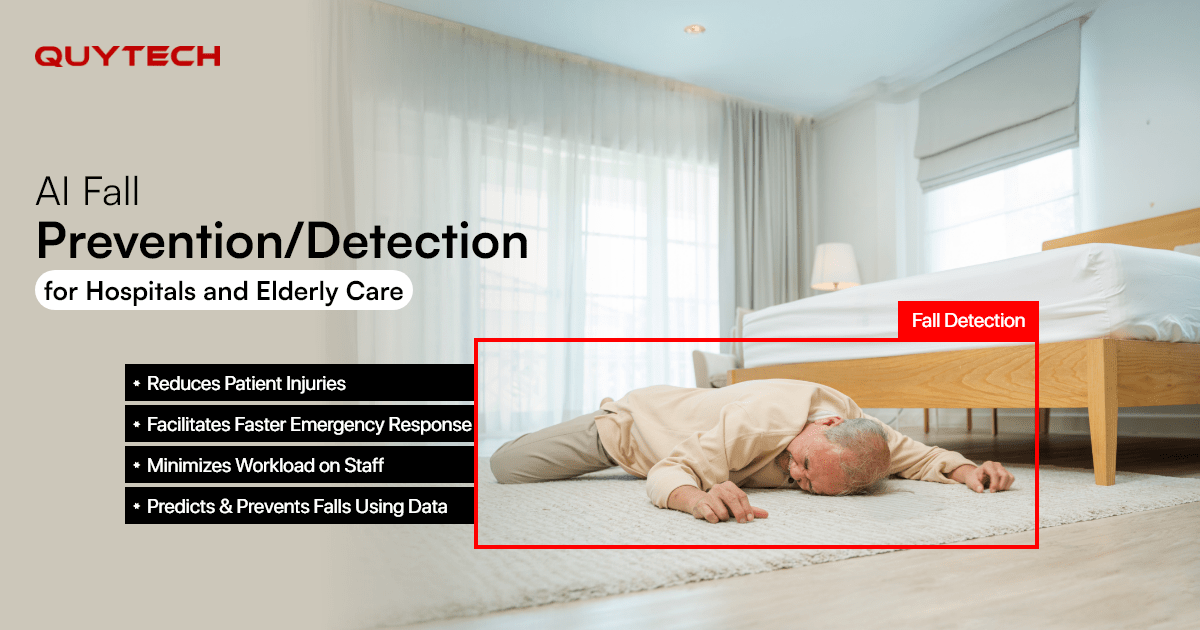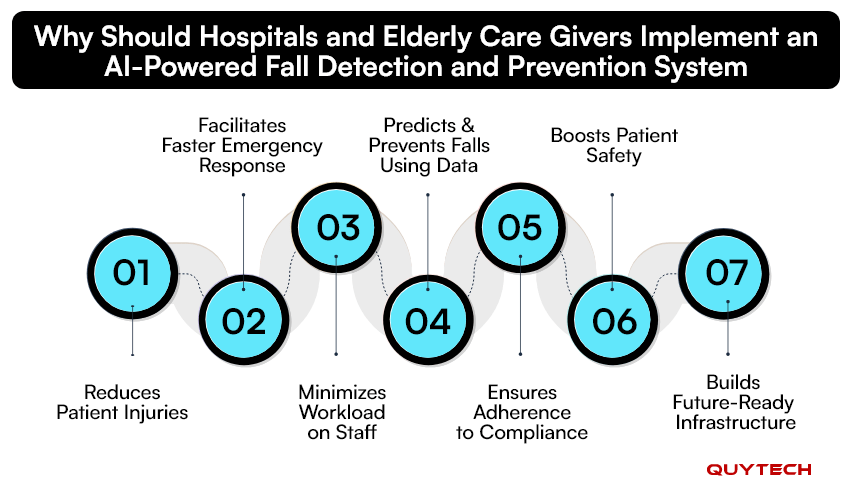An online study by Research Gate highlights that falls among people over 60 are one of the main reasons for accidental injuries and fatalities each year. Another study highlights that in 2024, hospitals and care facilities witnessed approximately 3 million emergency department visits due to falls among older people.
These numbers are proof that healthcare and elderly care facilities must have a way to prevent and detect falls among senior citizens. Yes, there has to be a system that can predict or prevent falls before they occur. Here is when AI fall prevention and detection systems enter the game.
AI fall detection can do wonders by transforming the way hospitals and care facilities monitor elderly patients and prevent falls that may restrict activities or cause serious injuries. But the question is how?
Let’s delve deeper into this blog to understand how to use AI for fall detection and prevention in elderly care in hospitals, elderly care homes, and other similar settings.
What is AI Fall Detection and Prevention?
Let’s begin with the basics. AI-powered fall prevention and detection means leveraging ML, computer vision, wearable sensors, IoT, and other technologies to predict the chances of a fall and detect the same among elderly and vulnerable patients. The system that facilitates fall prevention and detection can be integrated with security surveillance systems to provide these results and send an alert to caregivers for prompt action.
Traditional systems for the same purpose were dependent on patients or individuals to press the panic button or hospital staff to monitor each patient manually, which didn’t provide ways for real-time observation and fall prevention. An AI-powered fall detection system continuously monitors patients’ activities, behavior patterns, body postures, and other key aspects to prevent and detect falls.
Why Should Hospitals and Elderly Care Givers Implement an AI-Powered Fall Detection and Prevention System
Preventing falls and detecting them to respond immediately are indeed two compelling reasons why healthcare facilities, especially those that offer caregiving services mainly to older adults, should invest in AI fall detection and prevention system development. Besides these two, some other reasons for the same are:
#1 Reduces Patient Injuries
Falls can cause serious injuries, which could be fatal sometimes. An artificial intelligence-powered smart fall response system can help prevent and detect them in real-time to minimize the chances of injuries, like trauma, fractures, and other complications.
#2 Facilitates Faster Emergency Response
Artificial intelligence integrated within the falls detection and prevention systems enables them to immediately trigger an alert, like within a few seconds, upon detecting a fall or unusual movement. Caregivers can respond in no time.
#3 Minimizes Workload on Staff
AI facilitates automated monitoring of elderly or post-surgery patients. This reduces the need for manual observation and relieves the workload of healthcare professionals. They can focus on other critical tasks.
#4 Predicts and Prevents Falls Using Data
AI can make the most of data to analyze patterns, mobility changes, and patients’ behavior to predict high-risk movements. With this, the fall prevention and detection solutions can predict the chances of a fall.
#5 Ensures Adherence to Compliance
Hospitals and elder care facilities can utilize AI-based fall detection and prevention systems to ensure adherence to compliance associated with patient safety. It minimizes legal risks while building a positive reputation for the facility.
#6 Boosts Patient Safety
This is one of the biggest reasons an elderly care home or hospital should implement an AI fall detection and prevention solution. With artificial intelligence-powered monitoring, the care facility can prevent falls and ensure patient safety.
#7 Builds Future-Ready Infrastructure
Implementing AI-enabled fall detection and prevention for elderly care and other patients makes the infrastructure of the elderly care facility or home/hospital future-ready. This can give you a competitive edge while building a positive reputation for your facility.
You may also like to read: How to Build AI-Powered Crowd Monitoring Systems? CCTV Security Solution
How AI Detects and Prevents Falls in Real-Time
As aforementioned, conventional systems for detecting and preventing falls depend on human staff monitoring or the patients themselves to press the panic button. However, artificial intelligence-enabled fall prevention systems have changed this entire scenario by providing real-time monitoring or observation.
Apart from artificial intelligence, there are several technologies that run in the background to make smart surveillance possible.
#1 Collecting Data from Multiple Sources
AI-powered systems collect data from smart devices like smart bands and patches to track motion, balance, and vitals. Other sources it relies on to gather the data are security cameras and IoT sensors that are embedded in wheelchairs and beds.
#2 Monitoring Patients’ Behavior in Real-Time
The AI fall prevention and detection system then utilizes video analytics and motion tracking to observe certain patterns in patients. It analyzes body orientation, movements, and sudden collapses. It also keeps a tab on the wearables to get data on posture changes, unusual activities, and more.
Explore More: Suspicious Behavior Detection Systems in Banks: Complete Development Guide
#3 Analyzing Patterns
The system then utilizes AI and ML algorithms to process collected data and identify fall-prone behaviors. The AI-powered system can even flag unusual activities and movements that may result in a fall.
#4 Predicting Risks and Detecting Falls
The next thing an AI-powered fall detection system for elderly care and hospitals does is to trigger an instant alert upon detecting a fall or risk. How? Well, the system is connected with patient management systems, security surveillance systems, caregiving apps, nurse call systems, or staff wearables. As soon as a risk is predicted or a fall is detected, it immediately sends an alert to those systems.
You might be interested in: Developing Queue Detection AI Systems for High Traffic Scores
What are the Common Use Cases of AI Fall Detection Systems for Elderly Care and Hospitals
Here are the areas to implement an AI fall prevention system for elderly care and hospitals:

#1 Monitoring High-Risk Elderly Patients in Hospitals
The first use case of AI fall detection is to monitor aged adults after surgery. It can also be used to monitor patients with mobility problems or under heavy medication that may affect their body balance.
#2 Rendering Smart Surveillance in Nursing Homes and Long-Term Care
In elderly care facilities and homes, AI-powered smart surveillance facilitates round-the-clock monitoring while keeping in mind patients’ privacy. An artificial intelligence fall detection and prevention system can identify instability to ensure prompt intervention by professionals.
#3 Ensuring Remote Monitoring for Home-Based Elderly Care
AI fall detection and prevention systems can be implemented in residential homes for elderly care. These systems can connect with motion sensors, wearables, and smart cameras to enable family members or caregivers to ensure real-time monitoring of elderly individuals for falls and fall risks.
#4 Predicting Fall Alerts in Post-Surgery or Rehab Patients
Using AI for fall detection and prevention can be a game changer in monitoring patients in recovery, who are prone to temporary instability due to medications. These systems can detect signs of weakness or disorientation. They can even help with rehab planning to minimize the chances of a fall.
You may like to read: Intelligent Video Monitoring Systems Development: A Complete Guide
What are the Technologies Used in AI Fall Detection and Prevention Systems?
Several technologies run in the background to ensure successful fall detection and prevention. Apart from AI, other technologies that set the foundation of an intelligent fall monitoring and control system include:
#1 Machine Learning and Behavior Modeling
Both these technologies are used to make the most of vast datasets and derive critical insights associated with behavior analytics, movement patterns, risky movements, and more. Machine learning makes the system capable of self-learning from previous outcomes and feedback for better fall prediction.
#2 Computer Vision and Posture Recognition
The next core technology that is used in AI fall detection and prevention system development is computer vision. It connects with cameras to monitor body posture or orientation and detect unusual movements in real-time. The technology can also recognize fall-like behavior and immediately trigger alerts.
#3 IoT Sensors and Edge Computing
IoT sensors, equipped in wearable devices, smart floor mats, pressure mats, and others, continuously transmit data to AI fall detection systems. Edge computing ensures the processing of this data right at the point of its generation to facilitate real-time intervention.
#4 Integration with EHR and Surveillance Systems
It ensures the AI fall prevention system’s seamless integration with smart alarms, mobile applications, nurse call systems, and other solutions to raise an alert in real-time. With real-time alerts, medical professionals and caregivers can intervene quickly.
Explore More: How to Develop a Patient Record Management System?
How Quytech can Help with AI Fall Prevention and Detection
Quytech is an experienced and the most trusted AI video analysis solution development company with over 14 years of experience in artificial intelligence and video analytics. From AI-powered car damage detection systems and fire detection to accident detection systems, we have built all types of solutions for healthcare, education, manufacturing, automotive, and other sectors.
The fall detection systems we develop enable organizations and individuals to detect falls in real-time. While building an AI fall detection and prevention system, we focus on integrating custom AI algorithms that are trained on your specific datasets, using top-notch technologies to make your system future-ready, and implementing robust security, data encryption, and protection techniques to comply with industry standards and regulations.
Final Words
Traditional care systems, especially for elderly care, don’t provide means to prevent or real-time predict falls, which are one of the biggest causes of injuries among elderly care. With AI fall detection and prevention, hospitals and senior citizen care homes can adopt a proactive approach to prevent falls before they occur.
These systems also generate real-time alerts, which enable medical staff to promptly respond to those falls and ensure a safer environment for older adults. But how does AI fall detection and prevention work? What technologies are used to use AI for fall detection and prevention? The blog is a one-stop destination to get answers to all your queries associated with this.
FAQs
Artificial intelligence ensures a better quality of life by enabling round-the-clock monitoring, predicting the risk of falls, and ensuring real-time alerts to caregivers. It ensures a safer environment for elderly individuals at home or in healthcare facilities.
Yes, preventing falls before they occur and responding to ones as they happen are among the top challenges in senior care. These falls can cause severe injuries. AI can help solve this problem by offering predictive analytics, real-time monitoring, and automated alerting.
While implementing an AI fall detection system in elderly care homes, hospitals, and residential homes, one may face ethical and patient privacy concerns, cost and infrastructure-related problems, staff training, and proper implementation-related issues. These can be resolved by choosing the right technology partner for the implementation.
Such a system identifies unstable movements, such as patients feeling restless in bed or finding it difficult to get up from their bed. It also looks for room exit time and toilet time. The system analyzes body posture and orientation.




